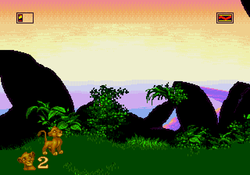Difference between revisions of "Dithering"
m (18 revisions) |
m (Minor spelling fixes.) |
||
| Line 8: | Line 8: | ||
[[Genesis]] relies heavily on dithering. The waterfalls in Sonic the Hedgehog are a classic example. A few [[SNES]] games use it as well (eg. Metal Warriors). Certain PS1 games, such as Silent Hill make heavy use of dithering. In that game it is used for shading. Many other PS1 games have a checkerboard. | [[Genesis]] relies heavily on dithering. The waterfalls in Sonic the Hedgehog are a classic example. A few [[SNES]] games use it as well (eg. Metal Warriors). Certain PS1 games, such as Silent Hill make heavy use of dithering. In that game it is used for shading. Many other PS1 games have a checkerboard. | ||
| − | Dithering is frequently used for | + | Dithering is frequently used for transparency effects in systems that cannot properly do them. [[Sega Saturn]] for one. The Saturn port of Castlevania: Symphony of the Night uses dithering for dialogue boxes, whereas the original Playstation version has proper transparent boxes. |
Many older computer games used dithering, though unlike with console games, it was not expected for the dithering to be blended into solid colors or proper transparency due to the sharper output of PC monitors. Of particular note are games for Japanese computers such as the PC-88/98, which often featured heavy use of dithering. | Many older computer games used dithering, though unlike with console games, it was not expected for the dithering to be blended into solid colors or proper transparency due to the sharper output of PC monitors. Of particular note are games for Japanese computers such as the PC-88/98, which often featured heavy use of dithering. | ||
Revision as of 12:01, 5 July 2014
Dithering is a technique to increase the amount of color and shading that can be done on a system. The effect is achieved by using lines or dots which are then blurred by the low quality cables (composite or RF) that the system uses. Modern computers use higher quality cables, which means that the dithering ends up being sharp and unblurred.
Use in games
Genesis relies heavily on dithering. The waterfalls in Sonic the Hedgehog are a classic example. A few SNES games use it as well (eg. Metal Warriors). Certain PS1 games, such as Silent Hill make heavy use of dithering. In that game it is used for shading. Many other PS1 games have a checkerboard.
Dithering is frequently used for transparency effects in systems that cannot properly do them. Sega Saturn for one. The Saturn port of Castlevania: Symphony of the Night uses dithering for dialogue boxes, whereas the original Playstation version has proper transparent boxes.
Many older computer games used dithering, though unlike with console games, it was not expected for the dithering to be blended into solid colors or proper transparency due to the sharper output of PC monitors. Of particular note are games for Japanese computers such as the PC-88/98, which often featured heavy use of dithering.
Emulation
The intended effects of dithering is often lost in emulation due to PCs typically using VGA or HDMI cables. The dots or lines appear as they actually are with no blurring. Options:
- Accept the unblended dithering
- Remove the dithering entirely.
- Requires assets to actually be of a higher color palette. Enabling 32bit colors in ps1 emulators achieves this, as dithering is done by hardware during 16bit conversion to output.
- Use a blurring or NTSC Composite shader which reproduces the same amount of blur as the original composite cables
- Use a dithering shader designed to just blend the dithering but does not blend the rest of the image.
Shaders
https://github.com/libretro/common-shaders/tree/master/dithering/mdapt-4p


